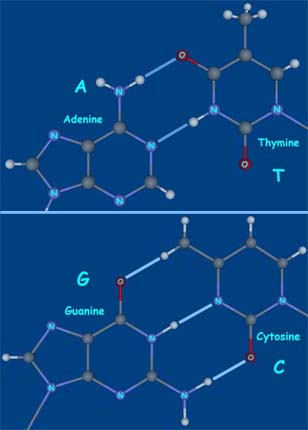|
The basis for the specificity of the A-T and G-C base pairing, and the coiling of DNA into a doublestranded helix, are shown on these two pages. Adenine and thymine pair by sharing two hydrogen bonds (below), with each base being a hydrogen donor in one bond and an acceptor in the other. The donor-acceptor roles in these two bonds are reversed in guanine and cytosine, and a third hydrogen bond is added. This role reversal insures that adenine cannot bond with cytosine, or thymine with guanine. Two purines (A and G) are too large to fit as a rung in the DNA double-stranded ladder, shown at the left, and two pyrimidines (C and T) are too small. Hence the only possible pairings on the two strands are A with T, and C with G. One further protection is given the genetic message. The doublestranded DNA ladder is coiled into a double helix, with the sugar-phosphate backbone on the outside and the base pairs inside, like treads in a spiral staircase. The buildup of the DNA helix is shown across the bottom of these two pages, and the finished helix in space-filling atomic models appears in the right margin. The double helix is a cylinder 22Å in diameter, with a wide groove and a narrow groove spiraling up the outside. Base pairs in adjacent steps of the staircase are 3Å apart. There are ten steps, or base pairs, in a complete turn of the helix, so one repeating unit of the helical framework is 30Å long. Right: The four bases of DNA, paired as shown. |

|